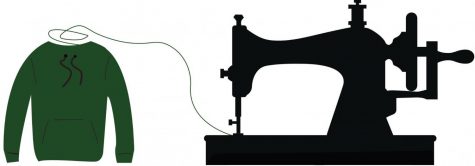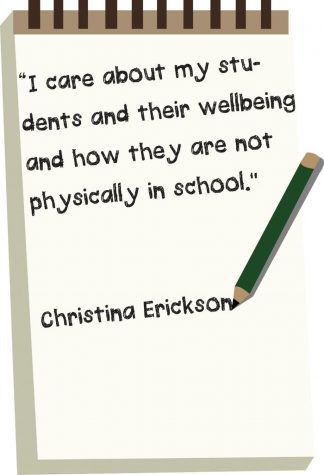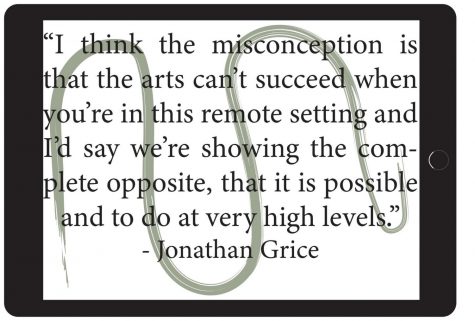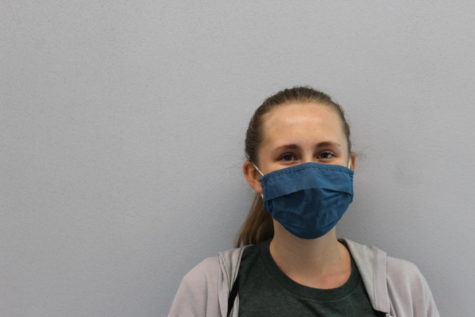The Art of Zoom
How the Applied and Fine Arts Classes are adapting to this new virtual environment of learning with their hands on approach.
No longer able to work in the Clothing and Design classroom filled with sewing machines and fabric, Amanda Klein ’21 is currently doing an independent study for the course. Currently in her third semester taking Clothing and Design 2, she begins to sew a sweatshirt in her makeshift at-home sewing room.
To adapt to the new way of schooling, she turned her dining room into her own design studio. It now holds her design book, sewing machine, patterns, fabric, and other design materials she will need. However, she still faces challenges when it comes to adapting to this new learning environment.
“It is more difficult to get feedback about your work before turning it in,” Klein said. “It is harder to ask the teacher for questions because you don’t necessarily see how many students are asking questions, and all you have is the chat feature and unmuting yourself and asking verbally.”
Klein’s independent study consists of using the wide range of skills she developed in other clothing classes and using them to create more dynamic articles of clothing, with little teacher guidance.
In order to help students adapt to the new learning environment, the Applied Arts Department provided students with necessary materials for the class they were enrolled in. Clothing and Design 2 students like Klein received materials like chalk, fabric, sewing machines and patterns. Food preparation classes had students pick up a bag of non-perishables and silverware, and print media students received new software to connect to Adobe through the school’s computers.

Clothing & Design teacher, Christina Erickson also talks about the struggle and new adaptations she needed to apply to this new way of teaching. Especially, with this class being such a hands-on class with sewing patterns and garments.
“Every year I get 10 sewing machines, and this happened to be my year,” Clothing and Design teacher Christina Erickson said, “So, by combining the number of old machines that we have and new machines that we have, and then asking students who had their own, we ended up having enough for every student.”
For Erickson, making sure that her students have as close of an experience in her class as previous students did is essential. Thus, she’s assigned group projects for presentations and had her students sew the same articles of clothing as previous years.
“As of right now, the way I have been teaching everything has changed, but everything I am assessing is going to be the same,” Erickson said.
Despite wanting to make the experience for this year’s students as close as possible to being in the classroom, the means of submitting students’ garments and patterns had to be changed. Thus, students will be submitting photographs of their garments for the sake of assessment.

In addition to changes in submission, the classroom environment has also shifted dramatically. Erickson noted that participation among students has also decreased in this virtual setting.
“As a teacher you have to work so much harder to keep the students engaged in what you’re doing,” Erickson said.
Students often receive several documents detailing the directions for their assignments, which are more challenging to understand than verbal instruction for some students.
“I don’t have her [the teacher] in class to ask what it means so I have to reread the directions and call her into my breakout room for help,” Klein said.
Nevertheless, the Applied Arts Department has worked hard to adapt these material dependent courses to be feasible virtually. Similarly, the Fine Arts Department has also been challenged with making several changes in curriculum this year. Production and performance based courses such as dance, musical ensembles, and visual arts are also continuing to run virtually this year.
“I think the misconception is that the arts can’t succeed when you’re in this remote setting,” said Johnathon Grice, head of the Fine Arts Department. “I’d say we’re showing the complete opposite, that it is possible to do at very high levels.”
Fine Arts teacher Patrick Fairchild is currently teaching Animation and Digital Art 1 & 2 from Zoom. Prior to the start of this semester, Fairchild had to change his curriculum and teaching strategy to fit within the parameters of the students’ homes. But, for Fairchild and his students, the biggest change with online school isn’t changes in curriculum; it’s the connections and communication between those in the classroom.
For instance, one of Fairchild’s Digital Art and Design 2 students, James Xie ’21, said that he has struggled with the changes in the feedback process.
“With Zoom it is just harder to get feedback,” Xie said.
Grice, however, noted that this virtual setting does provide some new opportunities with respect to obtaining feedback on the progress of students’ learning. For instance, polls and private chat features on zoom have enabled Fine Arts teachers to obtain live data regarding each of their students’ understanding whilst they are teaching the material.
“The feedback loop is engrained in the creative process and that is something that we’ve always prided ourselves on in the fine arts,” Grice said. “We are all about feedback.”
Evidently, virtual teaching has provided many possible outlets for communication between teachers and students. Thus, many teachers have taken different approaches, using a variety of methods to help their students. Xie said that despite his struggles with the feedback process, he has found Canvas to be a good resource for communication regarding his assignments.
“Whenever we are doing a project, if we need help we would submit our work on Canvas, and ask for help there,” Xie said. “Mr. Fairchild would show videos on how to use the software and fix certain aspects of the project.”
However, it’s not just the instant communication between teacher and student that is being missed in this virtual environment. The lost interactions between students and teachers brings a different attitude to school.
“I think bonding together as a class and getting to talk to each other and know each other, that’s the thing that’s probably lacking the most,” Fairchild said.
Despite the social changes of this new academic environment, Fairchild still seeks to make classes as engaging as possible. To do so in a home setting, computers were dropped off to his animation students.

While students are being taught with new methods, teachers are grading with the same EBR standards. Fairchild understands that online schooling is difficult and makes room for change and error in his grading.
“I guess, at the back of your mind you know it’s different working from home and not getting the same type of one-on-one instruction,” Fairchild said.
Although there are inconveniences, Fairchild knows it’s the right decision to be online for the time being. In person learning wouldn’t be the same with all the precautions that would need to be taken to stay safe.
“I think instruction isn’t 100 percent equal to what it was in the classroom but it’s not bad either,” Fairchild said. “It’s not like students aren’t getting the information they need; everyone’s getting by alright.”
Changes in instruction have been seen throughout classrooms and departments with respect to the arts this year. Nevertheless, the arts remain a vibrant part of the Stevenson community, even through the screen.
“Living in a world of virtual learning and living in a pandemic, I think the arts are more than ever needed to help students cope,” Grice said. “I think we’ve seen in the past four months how the arts have actually thrived and adapted in this setting as we’re learning to live through this situation.”



